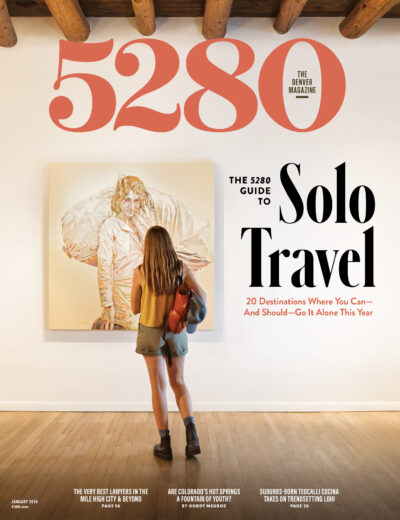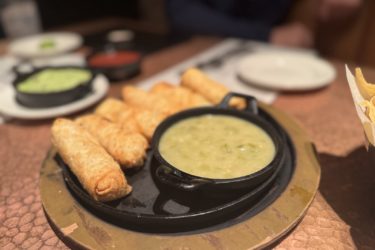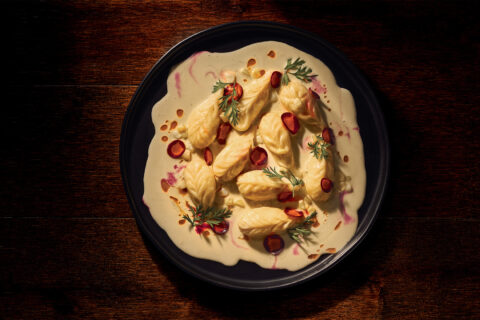The Local newsletter is your free, daily guide to life in Colorado. For locals, by locals.
Chef Jhordano Vasquez Roggero and Marisol Armas are on a mission to put Peruvian cuisine on the map in Denver. This past December, they came closer to reaching that goal by opening the Red Llama. At the Lone Tree spot, colorful pom poms hang from the ceiling, shelves are adorned with painted ceramic toros (bulls) that bring good luck and protection, and handmade red and yellow tables represent the fire used to cook signature Peruvian dishes.
“Everything you see—the colors, the tables, even the bathrooms—is because we want to do it that way,” Vasquez says, noting his and Armas’ intention to make diners feel like they’re in Peru. “This is my home; you’re eating at my table. I’m cooking for you, and my wife is serving you.”

Married for 14 years, the couple first met at an internet cafe in Lima, the capital of Peru. Armas, a Peruvian American raised in Denver, was visiting the neighborhood her uncle lived in when she crossed paths with Vasquez, who had just completed culinary school and was a chef at Punta Sal, a prominent cevicheria in Lima’s Miraflores district. After five years of long-distance dating, Vasquez joined Armas in the United States in 2013—and brought with him his dream to open a restaurant.

“The problem is, right here only exists a few Peruvian restaurants. [The cuisine] was not really popular,” Vasquez says. “We want to build something different, something authentic… and that happened finally.”
Armas grew up in the restaurant business; her father owned Benny’s Restaurant & Cantina, a Mexican establishment in Capitol Hill that closed during the pandemic after more than 25 years of operations. She never imagined herself getting back into it, but she was so inspired by her husband’s passion that the two teamed up in 2019 to start a small catering business. The venture, which sold Peruvian tamales and Thanksgiving turkeys, grew rapidly via word of mouth, and the couple soon began receiving calls asking for the location of their restaurant.
It took over two years to secure the physical space that is now home to the Red Llama. Vasquez and Armas assert that many landlords turned them down because they were unfamiliar with Peruvian food and thus didn’t believe in their vision. While the cuisine is harder to find in cities like Denver, it has gained recognition globally, particularly after Lima’s Central won the title of the World’s Best Restaurant in 2023. Here on the Front Range, the two restaurateurs are passionate about increasing awareness around and representing their culinary heritage.
“Peru has more than 400 varieties of dishes,” Armas says. “They’re all influenced by Asian, African, American, Italian [cuisines], so we cook with a lot of pasta, cheese, rice. You’ll see on our menu that we have fried rice.”
In the 19th century, Peru experienced an influx of immigrants from China, Japan, parts of Europe, and beyond. Upon their arrival, the individuals recreated dishes from their homelands utilizing the diverse array of ingredients found in Peru, including potatoes, chiles, and fresh seafood. “It’s a lot of Asian influences. If you go to Peru, you’ll see a Chinese restaurant on every corner,” Armas says.
At the Red Llama, Vasquez frequently cooks with soy sauce and uses a wok to produce dishes like lomo saltado, a beef stir-fry served with french fries and steamed rice. This and many of his other dishes, such as anticucho (skewered beef heart), have both Chinese and traditional Peruvian culinary influences—a style of food called “chifa.”
Whether it’s a chifa specialty, a tropical fruit dish influenced by Vasquez’s father’s upbringing in the jungle, or meals inspired by his mother’s Italian roots (like the tallarines a la huancaína con lomo, stir-fried noodles with steak in a cheesy sauce), each plate has a story linked to Peru’s diverse landscapes and cultural influences. There are also menu items inspired by the country’s coastal regions, such as the ceviche con leche de tigre (a citrusy marinade) served with white Peruvian corn and glazed sweet potatoes.
To add a taste of Peru to every dish, the couple imports key ingredients from the South American country. This includes pisco—a style of brandy, which Armas notes originates from the Ica sand dunes and is most known for its use in the pisco sour, Peru’s national drink—and a variety of regional chile peppers, such as the rocoto, Peru’s national chile, and ají amarillo, a key ingredient in the rich huancaína sauce. Even the ice cream on the dessert menu is made from creamy lúcuma, a fruit native to the valleys of the Andes that has a caramelized, butterscotchy flavor. “Everything we do here, we’re representing Peru,” Armas says.
At Red Llama, try the chicha morada, a deep purple beverage made in-house by boiling purple corn from the mountains of Peru with green apple, pineapple peel, fig, and spices like cinnamon and cloves. “People might think it’s food coloring or something or Jamaica (a term for hibiscus), but this is where it gets its purple color from: purple corn,” Armas says, holding a cob of maíz morado.
Since opening the Red Llama last December, the couple has served Peruvians from all over Colorado, as well as other states like Florida and California. Many patrons also come to the restaurant because they’re curious about the cuisine, or are traveling to Peru and want to learn about the country before they go.
“Vale la pena, [it’s worth it],” Vasquez says. “People ask me, ‘Hey, what’s the secret?’ I say, ‘Hey, there’s no secret…’ It’s details—details is the secret. If you have a lot of passion, a lot of love, you respect the process, it’s going to be beautiful.”
8331 Willow St., Unit B, Lone Tree








